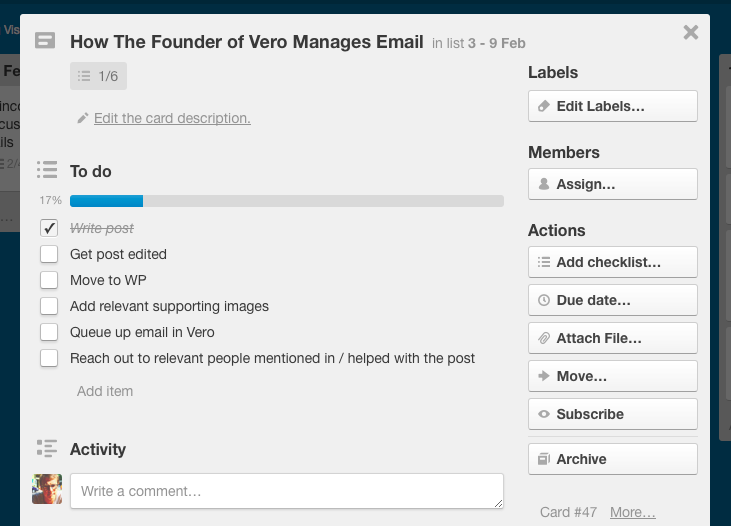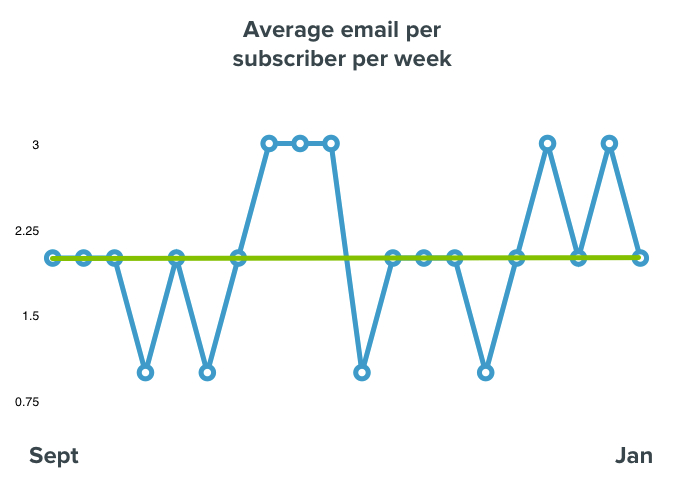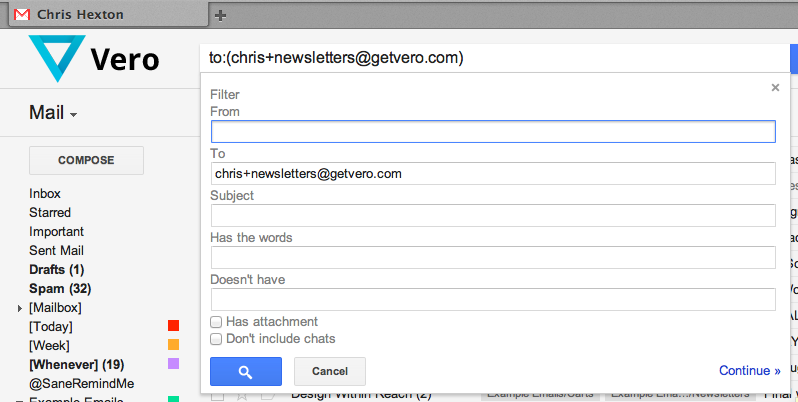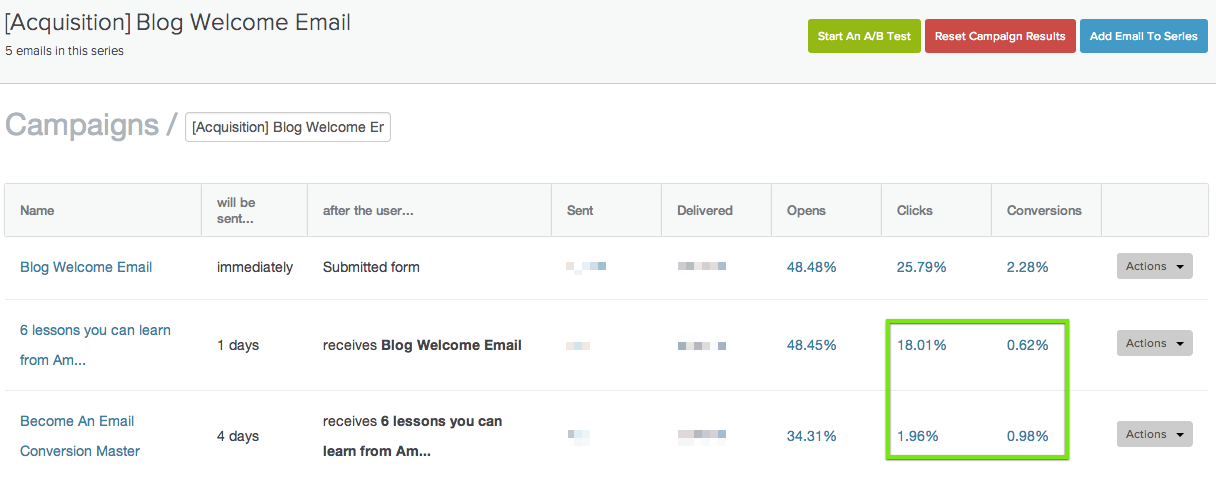How to Manage Great Content Marketing and Email Campaigns with a Small Team
-
UncategorizedUpdatedPosted:
On this page
“Lots of people ask how we manage to create great content and email campaigns here at Vero with such a small team.
In a nutshell, here’s the answer:
- We’re incredibly focused on consistency. We post to our blog at least once a week, we automate our quality emails and we talk to customers at least every two weeks.
- We plan ahead. Good work doesn’t happen over night: it takes time!
- We review all of our campaigns and automate what works.
Here’s our traffic over the last few months:
As you can see, we’ve really started to crank things up a notch: all thanks to the power of email and content. It really pays off.
Let’s dive and see how we manage our email marketing and content output here at Vero and give you 3 tips to better manage your own email and content campaigns that you can use immediately.
1. Plan ahead
If you’re going optimise your email marketing then the most important thing is consistency.
Consistency is absolutely king when it comes to content marketing.
It’s simple: commit to a timeframe (e.g. “I’m going to send at least one promotional email per week”) and do it!
This allows you to look beyond each individual post and email you create and look at why you did or did not perform. Rather than getting bummed when this week’s experiment failed you can focus on the post you have to produce next week: this perspective allows you to learn from everything that you do and then actually apply this learning.
If you don’t post consistently then it’s very easy to get despondent or focus on one particular failure.
Great consistency comes with thinking ahead. I use Trello and I break it down int three important Trello boards:
- “Marketing – Blog Posts”
- “Marketing – Email Newsletters”
- “Marketing – Design”
These are clearly pretty self-explanatory. Blog posts go in the ‘blog’ board, email marketing campaigns (promotional, produce updates, etc.) get planned and executed from the ‘newsletters’ board and design has tasks that support both of these, allowing our designer to produce the icons and graphics needed for our campaigns and content.
To show you how this is setup, here’s a shot of our email marketing board:

As you can see, we try to plan about one month in advance. There are four different types of email campaigns that get logged on this board:
- Partner promotion
- Product updates
- Emails to paying customers (notifications, usually)
- Feedback requests
You’ll notice that I don’t log any of our blog or content update emails on this board, as they are covered by the blog posts Trello board:

This board follows a similar pattern: we plan week-by-week and aim to be a month of ahead of today. Blog posts take a lot of work to pull together and there are no real tricks here: the board is a vital place to catalog blog post ideas and then evolve them over time until they have a place on our roadmap. Each ticket itself ends up having a todo a bit like this:

So, my top tips for planning ahead are:
- Write down ALL of your ideas: that way you always have a pool of thoughts to draw from for your marketing campaigns.
- Stick to the plan. The whole point of should spend time planning and base it around a hypothesis. Follow the plan, review, learn and then adjust what you do going forward.
- Share tasks for efficiency! If you’re a team of one, this means breaking tasks down so that you can tackle them one at a time: usually with a nice break in between!
2. Use different types of email campaigns for success
When breaking down our email marketing campaigns, there are three primary ways I think about our campaigns:
1. Blog post updates
These are email campaigns that are sent with the release of each new blog post and use a standard template. I customise the content personally eaech week with some copy and updated links to the newest post.
From time-to-time we experiment with the format of our blog post newsletters, but for the most past ours look like this:

Based on testing we’ve done to date, this one is the winner. Week to week, I don’t focus incessantly on these campaigns.
2. Promotional newsletters
I think of a promotional newsletter as an email that is not a blog post update and is not automated. This is where I find we really get to test things out.
Getting inspiration for promotional newsletters can come from anywhere, but I use two primary approaches.
Firstly, I think about the segments of customers in our database at that moment. Blog subscribers, email marketing course, trial users, paying customers, etc.
If there are a lot of ‘trial customers’ that haven’t ‘activated’ then I’ll think about how I might entice them to start a new trial or use a new feature we’ve released.
If I’m wanting to ensure paying customers see some new value in Vero then I’ll send them detail on a new product feature they’ve never used. For example, if a cohort of customers were found to have used automated campaigns but not our external attribute feature I’d send something introducing them to that feature.
I like to think about promotional newsletters in this way as it is the perfect way to ensure the right person gets the right message. If I begin by thinking about the target audience I find I’m more likely to come up with a campaign that suits them. Otherwise I’m just trig to fit a square peg in a round hole!
To support my theory, here’s the average number of emails received by each individual Vero subscriber over the past 4 months:

As you can see it has gone up, but certainly not dramatically. What is interesting is to compare this rather minor change with the huge change in conversion rates from our email campaigns over the same period.
In October 2013 we had an email to trial conversion rate of around 2%. That means, of all the emails we sent, 2% of recipients ultimately converted to the goal we were aiming for.
This isn’t bad but, by the end of January 2014, this number was 7.82%, which is a 450% increase.
Now, if a 450% increase doesn’t prove that using segments are invaluable, then I don’t know what does.
My second source of inspiration is a ‘swipe file’. I maintain a label in my Gmail called ‘Example Emails’ and I add emails to this by signing up to lots (and lots) of different email newsletters and trials.
If you want a simple way to maintain a label and do this too, make sure you subscribe to newsletters or company’s by slightly adjusting your email like this: ‘chris+test@getvero.com‘ or ‘your.name+newsletter@gmail.com‘. You can then create a filter in Gmail like this:

That labels all of the incoming emails you’ve signed up to automatically. Whenever you need inspiration you can pop into this label and see what sorts of campaigns you’ve been receiving and what ideas you might be able to test.
Don’t forget to test though: just because something worked for someone else doesn’t mean the status quo will work for you.
3. Automated campaigns
My approach to email automation is to test first and implement permanently later.
Using newsletters allows me to test out ideas quickly and then implement those ideas that work. into automated campaigns. This way the effect is permanent!
For example, I recently found that a newsletter we sent out to blog subscribers and Marketer’s Email Conversion Course graduates was a real hit. This campaign was pretty simple: it asked if the recipients would like to start a Vero free trial to put what they’d learned into practice.
Further to this, we recently researched which blog posts and blog post update emails converted better than others.
With these two successful experiments under our belts and backed up with data, we decided to automated two more emails to new Vero blog subscribers:
We now send subscribers our best ever article first (it looks like a standard blog newsletter) and then follow up with a specific call to action telling them about Vero’s free trial.
The result: instant success. Both campaigns provide conversions we may well have missed out on previously and faster than we ever could have received them before.
Moreover the first of these two emails have nearly 50% open rate and 18% click-through rate, which is really phenomenal.
There’s a lot to be tested here but the main takeaway is that you should always focus on trying to get sound numbers before automating. There is no point automating a flawed system so never get too caught up in building the ‘perfect funnel’ from the word go: start small with your automated campaigns, test some newsletters and then go big.
Reporting
Learning from your campaigns is the most important aspect of the email marketing process.
Each week I spend time reviewing the email campaigns we sent out in the last 7 days in order to develop a plan to implement in the coming week.
To measure success I focus on a single metric and, in most cases, this is getting customers to sign up for a free trial.
There are two ways that I find this data. The first is using Google Analytics. As I use Vero, I can append the campaign subject line as a utm_campaign (i.e. Vero does this for me automatically). That makes it super easy to see how each campaign has gone with all the events and goals I have in GA:

The alternate way (and I like to cross-reference) is using Vero’s conversions column itself. Each and every campaign I send in Vero has a specific goal and Vero automatically reports the results of a campaign against this goal.

From the example above (in point two) referencing our new automated emails – as part of our blog welcome series – it’s easy to see the number of people that reach a specific goal for a campaign. In the case of that campaign, it is to sign up for a free trial. This is also super useful when running A/B tests as it makes it easy to see, at a glance, how effective each campaign and campaign variation is.
Remember: looking beyond opens and clicks is super important. Make sure you track conversions.
Conclusion
Pulling together great email campaigns takes time and thought but it pays off massively.
Staying organized will ensure that you not only send better emails but learn more from each and every campaign, improving your learning rapidly.
If you are interested in how you can plan out your campaigns, feel free to get in touch and definitely check out our guide on on how to setup your lifecycle email campaigns – it includes a spreadsheet template for mocking out your lifecycle campaigns.
Want to send more personalized mobile and email messages to your users?
Learn moreCustomer story

How Vero helps Plann cater to the needs of an agile startup that's scaling up quickly


